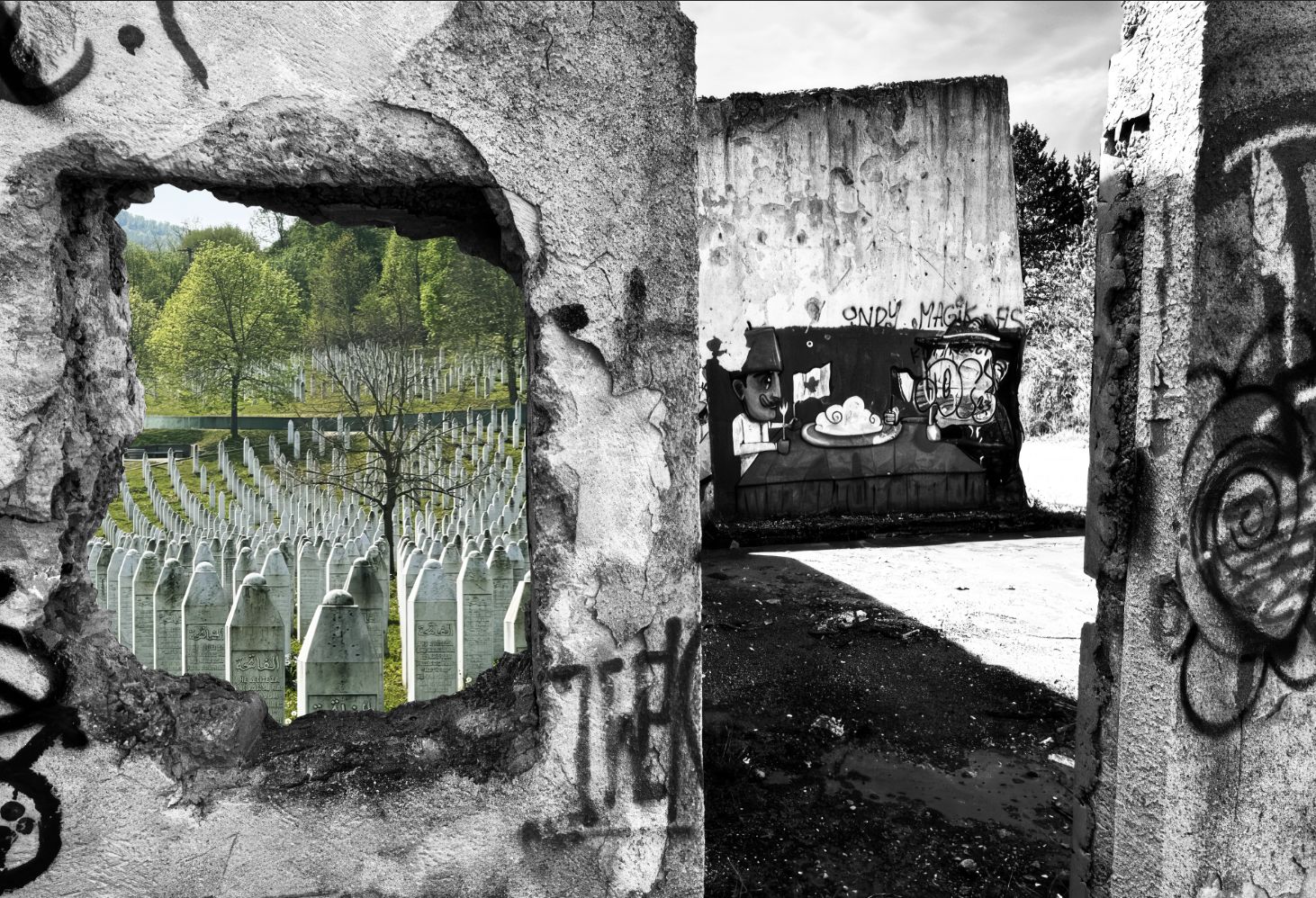It was springtime when my companion and I met up in Sarajevo, or Saraybosna, Turkish for Palace or Court of Bosnia. The city was once the westernmost frontier of the Ottoman Empire, which conquered it in the 14th century, leaving behind many familiar markings — the call to prayer from mosques, gushing fountains in courtyards and a myriad of Sufi traditions on display — making it a unique window into Islamic history in Europe.
Today, Bosnia also evokes memories of Europe’s worst genocide since WWII. And in recent reports, NATO considers it among the “partners at risk,” as Moscow’s meddling in its affairs has grown since Russia invaded Ukraine in 2022.
Both its history and geopolitics are familiar to me. Having witnessed war and displacement during an itinerant childhood — in Algeria, Lebanon, Syria and Saudi Arabia — when my family aimed to stay ahead of war and economic stagnation, I wanted to see what a nation with parallel challenges to the Middle East might look like in Europe.
As I disembarked from the airport taxi near my hotel in the old city, I noticed the light from the streetlamp casting a gentle yellow hue on the cobblestoned street, which briefly caught the wheel of my suitcase. The scene captured an old-world charm that reminded me of other former Ottoman places like Aleppo, which sits ruined after Syria’s 13-year war. Perhaps, I thought, Sarajevo serves as an example of how a place once lost to war and besiegement can find its way back from the brink, despite facing internal fault lines that lend themselves to foreign exploitation.
It was still Ramadan during our time there. Just as we took our seats at a table for two outside, we heard the traditional iftar cannon fire in the distance, an iconic soft boom that remains ubiquitous across former Ottoman lands. About half of Bosnians identify as Muslim, according to census data. One-third identify as Christian Orthodox Serbs and 15% as Catholic Croats.
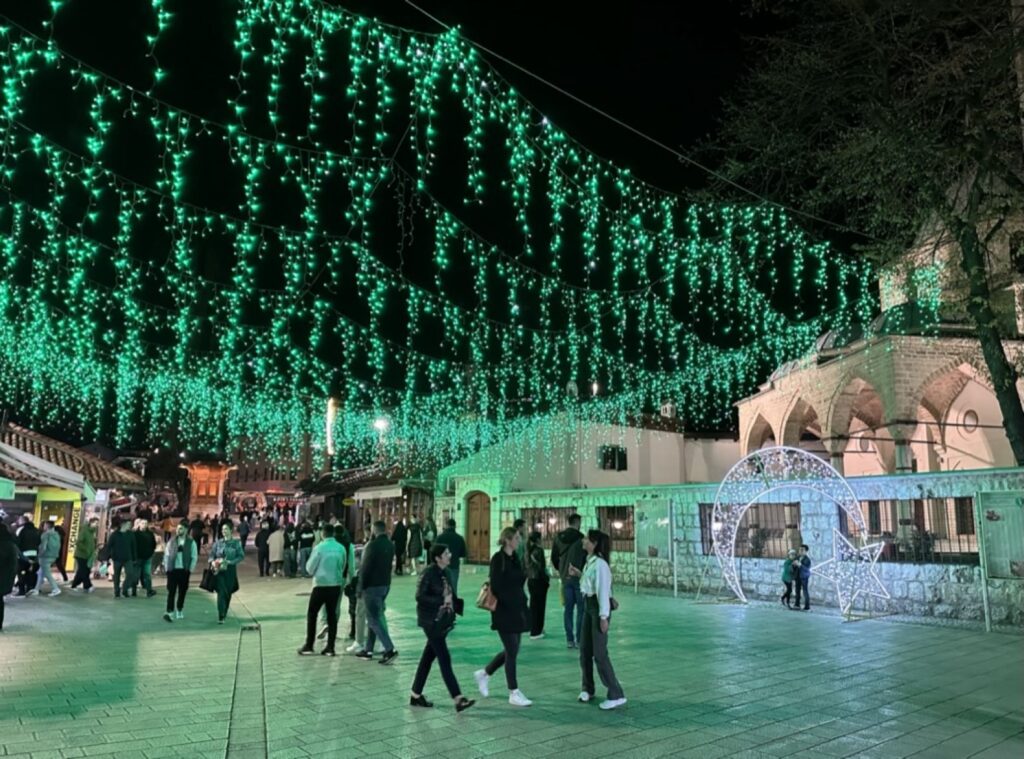
Our visit also coincided with the anniversary of the infamous siege of Sarajevo. The siege started a month or so after Bosnia-Herzegovina — one of six republics emerging from the breakup of Yugoslavia — declared its independence in March 1992 in a referendum recommended by the European Community. Bosniaks — as Bosnian Muslims refer to themselves — and Croats voted for it, but Serbian nationalists opposed independence and boycotted the vote, resenting the idea of becoming a minority in the newly formed Bosnia-Herzegovina. These divisions sounded familiar. People born of one nation and one tongue conceptualize themselves as separate from one another, more comfortably aligned with the culture of a foreign country than their own countryfolk. In Bosnia-Herzegovina, the country’s Serb nationalists identify as an extension of the state of Serbia, a longtime Russian ally, and refer to Bosniaks in the pejorative, calling them “Turks.” (The Serb nationalists later formed the Republika Srpska (RS), as a continuation of their warring party that was folded into the tripartite agreement among the country’s Bosniaks, Croats and Serbs at the Dayton Accords, hosted by then-U.S. President Bill Clinton in Ohio in 1995. Today RS remains a secessionist entity.)
In Sarajevo in 1992, despite the ethnic cleansing that had begun in the north, protests in the capital remained peaceful — until a fatal attack on April 5. That day corresponded with the holiday weekend commemorating both Sarajevo’s liberation from Nazi Germany and the day that Bosnia-Herzegovina’s independence was to come into effect. It was also the first day of Eid al-Fitr, a three-day holiday to mark the end of Ramadan through feasts and festivities with loved ones. Instead, two women were gunned down by sniper fire in a street not too far from where my companion and I were having our iftar, the image of their fallen bodies memorialized in a permanent exhibit at the Museum of Crimes Against Humanity and Genocide. They are wrapped in an embrace, for they tried to shelter each other from bullets. Today, they are remembered as the first victims of the siege, a sad point of departure from the peace that could have been.
What followed their death was three years and 10 months of besiegement — a year longer than the siege of Leningrad — making it, for a time, the longest modern-day siege of a capital city, until the siege of Ghouta (Damascus), which ended in 2018 after five years and one week. Having personally witnessed the latter, and as I learned more about the siege of Sarajevo, a morbid familiarity arose, for human cruelty has a homogeneous face, no matter the context. In both sieges there were sniper alleys where grandparents, mothers and children ran for their lives. Sometimes their fallen bodies were tended to by a loved one, who were also struck and killed by sniper fire. There were hungry families who stood waiting in bread lines but never got their turn. Rockets shelled people’s homes, reducing apartment buildings to their skeletal structure, broken concrete and twisted steel revealing lives interrupted.
Also familiar are the heroic acts carried out by ordinary people. Inside the genocide museum in Sarajevo, I read a story about Islam Dugum, a local marathon runner who left Sarajevo several times during the war and participated in various international competitions, including the Mediterranean Games, carrying the flag of Bosnia-Herzegovina. During these trips he would connect with refugees and exiles from his country and gather aid to bring back to Sarajevo, smuggling it through the Tunnel of Hope, which was built in the early months of the siege and remained the only way in or out of the city until the end of the war. Among the more privileged of his countrymen by virtue of being able to travel, Dugum found himself serving his compatriots by becoming a smuggling mule. It’s a story familiar to millions over recent decades and in so many conflicts. Ordinary civilians find they must smuggle on their person all manner of things: medicine, food and cash for the loved ones stuck back home and in desperate need of aid, no matter the risk of such transport. I’m now bearing witness to friends doing just that to help their loved ones stranded in Gaza, as I have similarly done for loved ones during the war in Syria.
One of the more deplorable details of the Sarajevo siege that I came upon is the documented macabre presence of “manhunting tourists,” a chilling term coined by film director Miran Zupanic in his documentary titled “Sarajevo Safari,” alleging a trend of rich foreigners who paid money to shoot at people in besieged Sarajevo. One such “tourist” was the late Russian writer Eduard Limonov, a Soviet dissident who immigrated to the United States, then returned to Russia in 1991 and founded an ultranationalist party. Though it’s unclear if he paid for the sordid opportunity, he was filmed at a Serbian shooting post on June 22, 1992, accepting an invitation by Bosnian Serb leader Radovan Karadzic to fire a machine gun, aiming it at the streets of Sarajevo below. He fired several rounds, stopping briefly to allow Karadzic to adjust the gun’s tripod mount before carrying on with the task. My eyes lingered on the TV screening this footage on a loop inside the genocide museum, and I tried to understand why — and how — a fellow writer, whose job requires cultivating a sensitivity to the human condition, could so easily steel himself to snuff a life in cold blood.
War, I find, upends society, not just by leaving a trail of destruction but also by forcing to the surface what otherwise remains hidden, like the way a storm dredges up muck from a riverbed. In this muck one finds society’s moral malaise, the covert and base parts of human nature cajoled to the surface by violence and calamity. War can also bring out the best of humanity. During the war in Syria, almost anywhere I looked, I saw both: People who were emaciated from living under siege shared the little food they had in their possession with others, and people who had no good reason to hate aimed their gun and killed a stranger. One time I saw a crazed gunman aim his semiautomatic weapon and shoot a donkey that was minding its own business. Another time I was stuck in traffic behind a truckload of armed militia members when I noticed one of them pointing his rifle at me from his perch on the truck bed, glaring down at me and smirking, hoping perhaps to meet my eye behind my sunglasses in whatever sick sense of power he felt. Thankfully, traffic moved and something else distracted him.
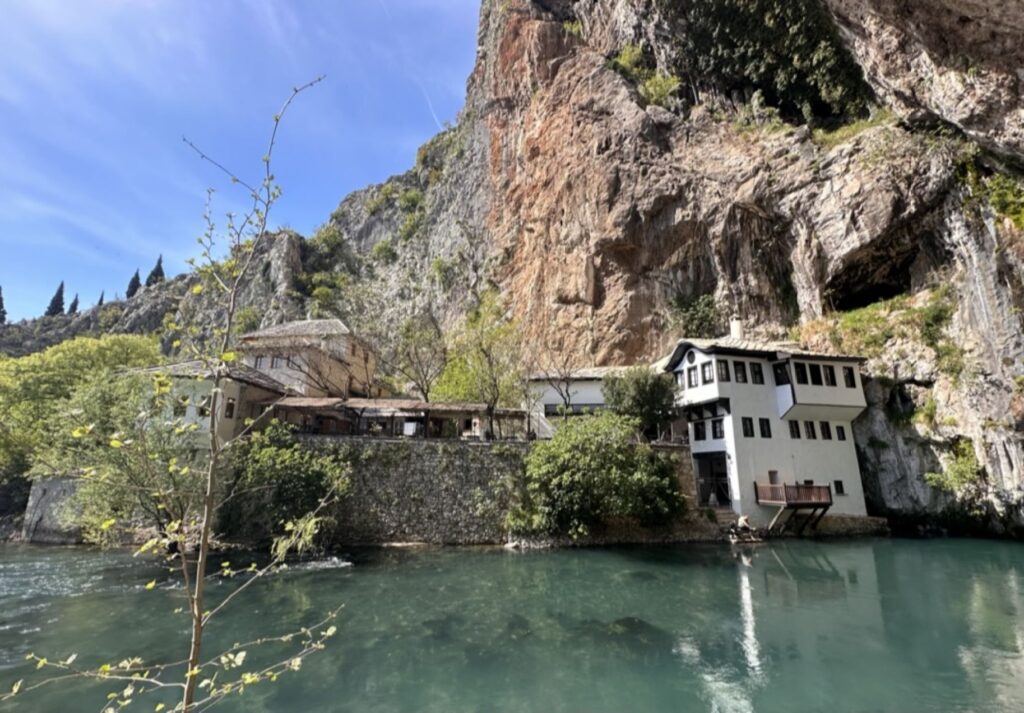
My companion and I rented a car and drove the backroads, stopping frequently to take hikes in the woods, which are pristine and beautiful throughout Bosnia. Public spigots offered up crisp water from the streams. Around us small family-owned farms raised lamb and kept bees. The summer heat had not yet arrived, so on the surface everything seemed idyllic.
But a startling aspect of driving through Bosnia-Herzegovina is the demarcation of territory by the secessionist Republika Srpska. We saw this often: the RS flag (which resembles the Russian one) hoisted on a pole atop a Serbian war memorial or public square visible upon entering a town, announcing RS-controlled territory. These territories, which take up much of the northern and southeastern regions of Bosnia-Herzegovina, continue to cultivate a distinct and separate identity steeped in Serbian nationalism, teaching their own curricula in schools, including their version of the war and the siege, in which they largely deny the crimes committed in the name of Serbs. Serbia has been pushing to unify its school curricula with that of RS, which would exacerbate an already precarious situation of a Russian-backed Serbian nation within the state of Bosnia-Herzegovina, a country that hopes to one day join the European Union. (However, many locals say this goal is too lofty given their country’s dire political and economic structure, even without the complication of a ministate within a state.) Even roadside signage of town names reveals a low-grade battleground for territoriality, with graffiti blacking out either the town’s Cyrillic or Latin spelling. In yet another illustration of the complexity of nationhood, both Cyrillic and Latin are official scripts in Bosnia-Herzegovina, but the former is dominant in the RS while Latin is the default letter throughout the Croat and Bosnia-controlled entity, known since the Dayton Accords as the Federation of Bosnia-Herzegovina.
These divisions, along with an unabashedly corrupt, multiconfessional government, reminded me of the state of affairs in Lebanon, where the authorities have also failed to unify a school curriculum that teaches a national narrative. By relegating the retelling of the country’s history and its civil war to the whims of sectarian narrators, the promise of another sectarian conflict remains ever within sight. And this is also the case, it seems, in Bosnia-Herzegovina.
On May 24, the U.N. General Assembly voted to establish an annual day of remembrance for the Srebrenica massacre, much to the chagrin of Serbia and Bosnian Serb leader Milorad Dodik, who promptly held a press conference and declared: “There was no genocide in Srebrenica.” Jasmin Mujanovic, political scientist and author of “The Bosniaks: Nationhood After Genocide,” told New Lines that in reaction to the General Assembly vote, RS special police forces were seen deployed around Srebrenica in a show of force. “This was very clearly intended as an attempt to intimidate, harass and terrorize the local population having to do with the U.N. vote.” Mujanovic added that there’s been “an alarming upsurge in attacks” against Bosniaks returning to their homes in the Serb-run northern and eastern parts of Bosnia-Herzegovina, after having been expelled during the war. “In general, the day-to-day situation for the Bosniak community in parts of RS has deteriorated and there’s a pervasive culture of fear that permeates, as Dodik rhetoric and politics have escalated over the past year and a half.”
As our visit to Bosnia-Herzegovina was coming to an end, it was finally time to bear witness to Srebrenica. I had been to other places where crimes against humanity were committed, where little or no justice and reconciliation occurred, where a terrible truth remains unacknowledged, considered a mere “opinion” depending on “whose side you’re on,” or a fact that no one dares utter.
In the mid-2000s, I visited the Syrian town of Hama. It was some years after the infamous 1982 massacre perpetrated by the Assad regime against a local uprising, killing en masse over 20,000 people including, as is typical in genocidal acts, entire families. What struck me most about the place, as I walked through its streets, was how guarded the people were, how reluctant they seemed to greet a stranger and how their suspicious demeanor differed from the lackadaisical hospitality found elsewhere in the country. I recall one aspect of Hama that was especially chilling: When I found myself walking atop a mound surrounded by relatively new construction. It was the site of the mass grave where the regime dumped the dead bodies after the mass killing, then covered them with dirt and built a parking lot. The silence that ensued, the lack of international outcry without consequences for the perpetrators or justice for the victims, hung so heavy in the air. Nowadays in Syria, along with many towns in Iraq, Lebanon and elsewhere in the region, not to mention the ongoing war in Gaza, Hama is merely one among many such sad places.
Would Srebrenica have a similarly haunted feeling, I wondered?
It was impossible to miss the Srebrenica Genocide Memorial by the roadside upon our approach to the town, with over 6,000 marked graves, including a few fresh ones. As unmarked graves continue to be found all over the country, their contents are exhumed and identified before being reburied at the memorial cemetery. It happened to be the second day of Eid al-Fitr when my companion and I found ourselves there. Around us a constant trickle of families arrived to visit their dead loved ones, as is customary during Eid for many Muslims, for as always when the deed is done, death is hardest on the living.
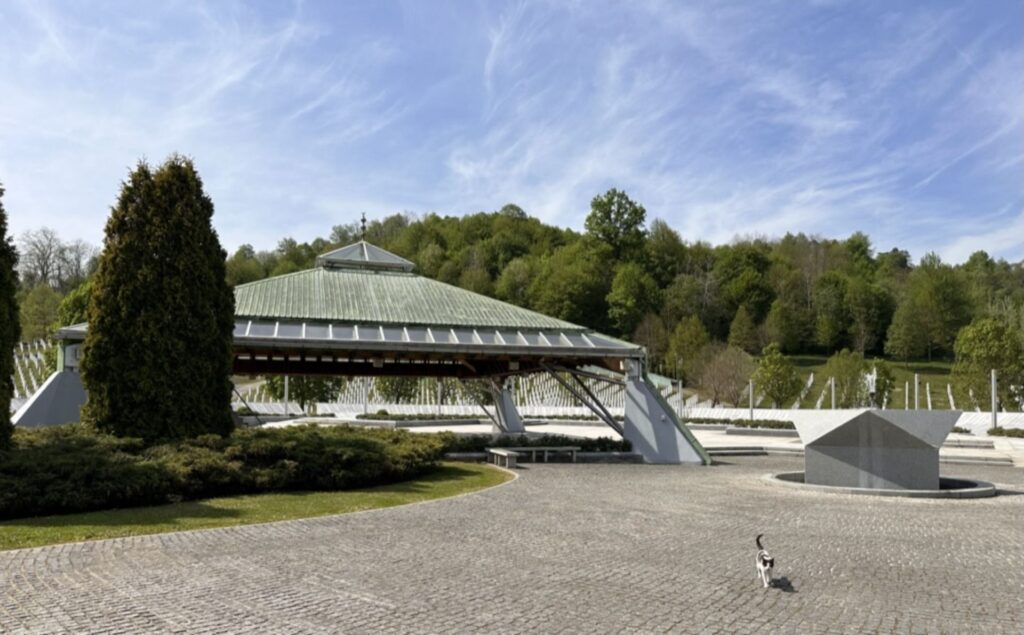
Across the street stood derelict structures that once housed the United Nations Protection Force (UNPROFOR), where one of the many failures of the international community tragically unfolded. In the early hours of July 6, 1995, Serb forces attacked Srebrenica and the Dutch Battalion peacekeepers (Dutchbat) who were stationed there as part of UNPROFOR. Over the next few days, the villages around the town of Srebrenica and the U.N. outpost fell to Serbian forces, despite the Dutchbat’s repeated requests for support from the U.N. and NATO — support that never came for reasons that remain unclear. As Serbian forces tightened their siege of the area, Bosniaks fled on foot, making their way to the town of Srebrenica, which fell to the Serbs on July 11. Serbian forces made no secret of their intentions, nor of the long-running nature of this conflict.
“The time has come to take revenge on the Turks here,” Bosnian Serb Gen. Ratko Mladic announced upon entering the city, which the U.N. had designated a safe zone. Mladic was referencing the Battle of Kosovo, where the Ottomans defeated a Serbian prince in 1389.
More displacement followed. Bosniak men and boys formed a column and set off into the woods, aiming to get through Serb territory to the safety of Bosnian-Herzegovinian territory. Some 30,000 women, children and elderly started moving toward the U.N. compound, seeking haven and humanitarian assistance.
The Dutch soldiers tried to help. They cut an opening in the fence of their compound to allow in as many refugees as they could, which, given the limited space, overflowing toilets and dwindling food and medical supplies, was not many. They kept requesting support from the international community — humanitarian airdrops and NATO air cover that never came. (The Dutch government has recently apologized to Dutchbat veterans, acknowledging that they had been sent on a mission “that ultimately proved impossible to carry out,” as the world failed the victims of the Srebrenica genocide “in the most terrible way.”)
There is footage of Mladic addressing the refugees, promising that none would be harmed as they were about to be (forcibly) transported in busloads out of Serbian territory — promises he had no intention of keeping. He suggested that the women and children go first — for chivalry’s sake, he implied. But in reality, he had other plans for the men.
The buses for the evacuation started to arrive, and with the Dutchbat peacekeepers standing by, the Serbs began to separate the men and boys from the rest of the refugees. The Serbs also captured thousands of Bosniak men and boys from the column that had struck out on foot into the woods.
Over the next few days, Serbian forces systematically executed in cold blood some 8,000 Bosniak men and boys. They did this in meadows and on military farms, in abandoned school buildings and inside former cultural centers. Survivors later told their horror stories during testimonies at The Hague.
My companion and I managed to enter the nearly abandoned compound, which is closed to the public, and walked through some of its precariously unsound structures that have remained standing and unchanged since the war. Inside one warehouse, a dark water-filled square pit stood out in the otherwise smooth but filthy concrete floor. An animal the size of a pig floated on its surface, bloated and dead for some unknown amount of time. It seemed an apt metaphor for the horrors this place had witnessed — horrors that U.N. peacekeepers had been powerless to prevent.
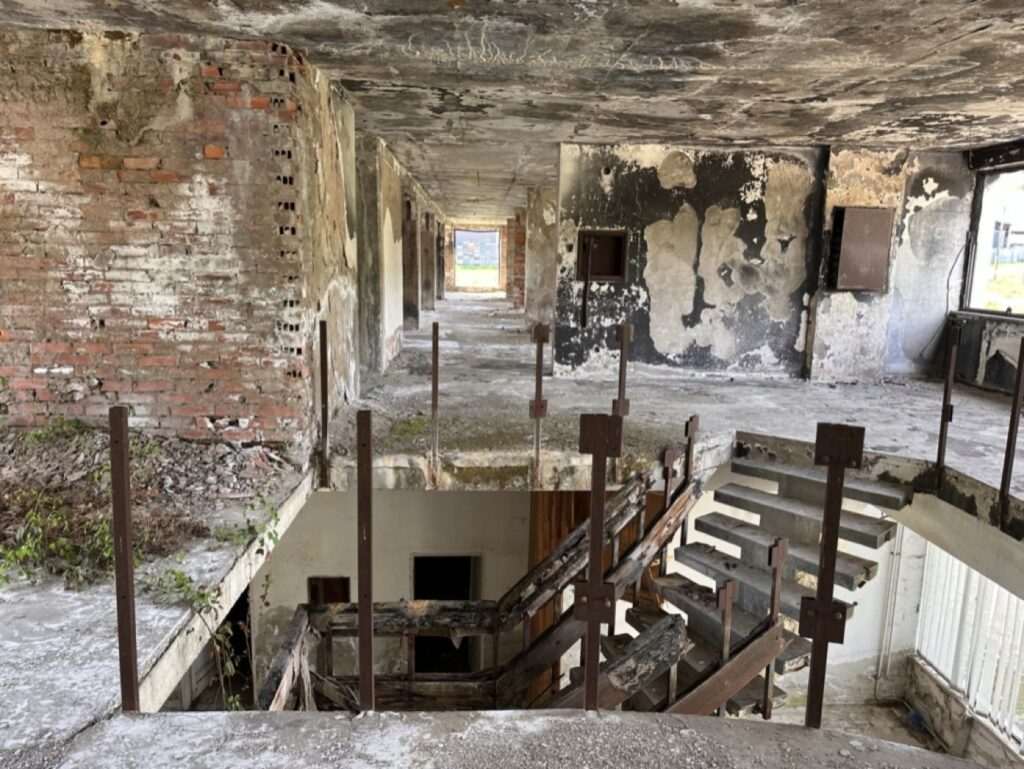
As Bosnia-Herzegovina continues to confront genocide denialism, successionist factionalism and increased foreign meddling, what does the future hold? Is it a failed state like some of the countries I once called home?
I put this question to Peter Lippman, author of “Surviving the Peace: The Struggle for Postwar Recovery in Bosnia-Herzegovina.”
“The short answer,” he said, “is that Bosnia-Herzegovina is a particular form of dysfunctional state ruled by corrupt domestic politicians under the full enabling of international officials.” Lippman added that the country is still “in its postwar form and has not yet had the chance to be a state, so it cannot be a failed state in the classic definition.”
Perhaps one sentiment that my companion and I overheard on a hike captures the overarching mood in the country. It came as a response to tourists wondering aloud, in English, whether they could park their car near the trailhead.
“Yes, yes, it’s OK. A policeman comes and you give him 10 marks,” a local, middle-aged man assured them with a chuckle. “This is Bosnia. It’s the wild, wild west.”
And that, too, rang familiar.
Become a member today to receive access to all our paywalled essays and the best of New Lines delivered to your inbox through our newsletters.



